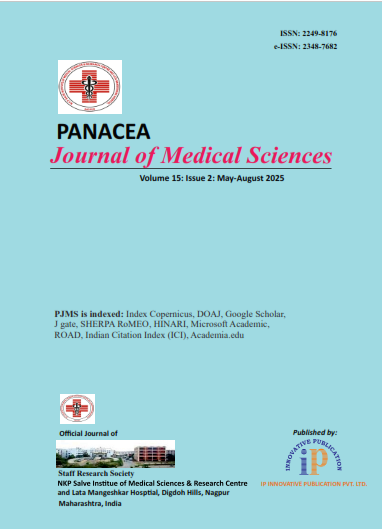Panacea Journal of Medical Sciences
Panacea Journal of Medical Sciences (PJMS) open access, peer-reviewed triannually journal publishing since 2011 and is published under auspices of the “NKP Salve Institute of Medical Sciences and Research Centre”. With the aim of faster and better dissemination of knowledge, we will be publishing the article ‘Ahead of Print’ immediately on acceptance. In addition, the journal would allow free access (Open Access) to its contents, which is likely to attract more readers and citations to articles published in PJMS.Manuscripts must be prepared in accordance with “Uniform requiremen...

Assessment of the epidemiological overlap among morphologically identical species of entamoeba among the patients attending Calcutta school of tropical medicine
Page: 458-464
Introduction: Parasitic infections like Amoebiasis are endemic to most tropical and subtropical regions of developing countries like India. Among Entamoeba species, Entamoeba histolytica, the causative agent for amoebiasis, is highly pathogenic while the other species are considered as non-pathogenic and needs no medical treatment in most of the cases.
Aim & Objective: To estimate the accurate prevalence of infection by different microscopically identical species of Entamoeba in human faecal samples by PCR based identification among patients attending a tertiary care hospital in Kolkata.
Materials and Methods: A total of 1837 stool specimens in this study were collected from patients attending department of Calcutta School of Tropical Medicine for a period of 12 months. Stool samples were screened via microscopy for Entamoeba species identification followed by confirmation by conventional Polymerase chain reaction. Data were analyzed with Graph pad Prism 9.
Results & Discussion: In the study, 91/1837 (4.95%) samples were microscopically positive for Entamoeba cyst or trophozoite and 81/1837 (4.41%) were Polymerase chain reaction positive for Entamoeba. E. moshkovskii infection (38.27%, 31/81) appeared to be the most predominant, followed by E. histolytica (19.75%, 16/81); E. dispar (9.88%, 08/81) and E. poleki (1.23%, 01/81) while 25/81(30.86%) belonged to other Entamoeba species.
Conclusion: The results provide an important data for the clinician about the advantages of PCR over microscopy and also discriminate non-pathogenic Entamoeba species from the pathogenic E. histolytica to avoid unnecessary treatment with anti-amoebic drugs.
Article Metrics
- Visibility 16 Views
- Downloads 5 Views
- DOI 10.18231/pjms.v.15.i.2.458-464
-
CrossMark
- Citation
- Received Date July 23, 2024
- Accepted Date March 02, 2025
- Publication Date August 19, 2025